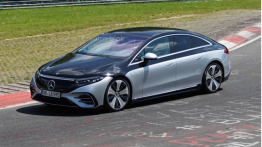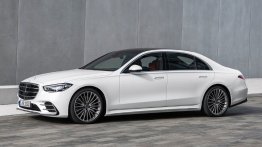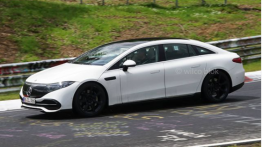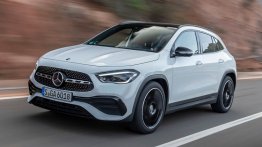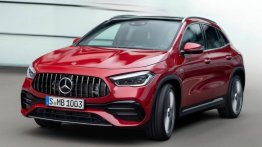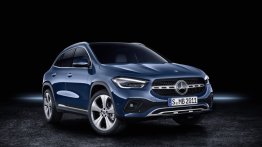The E-Class is the world's most successful business saloon with ten million models sold over a period of sixty years
The new E-Class Saloon is the successor to a Mercedes model that has been successful throughout the world, achieving sales of more than 1.3 million units since 2002. In Germany, more than 40 percent of all saloons in this market segment have the "E" in their model designation, and in many western European countries this Mercedes model series is the number one in the luxury class.
Since 1947, when the Model 170 V was introduced as the direct forerunner of the E-Class, Mercedes-Benz has produced more than ten million saloons in this vehicle category. This makes the E-Class the world's most successful business saloon by far.
Closer to home, the E-Class has carved its name on the Mercedes-Benz India's hall of fame. The
E-Class was the first locally produced Mercedes-Benz in the country and by far the enduring favorite in India with over 10,000 Indian customers preferring the E-Class as their chosen Mercedes.
The New E-Class stands for status, quality, highly advanced technology and driving pleasure – and it also reflects these attributes in its self-confident design. All these factors mean that the new E-Class promises to be a real trend-setter.
There is much more to the world's best-looking car than just its appearance. The special characteristics of the world's top-selling luxury saloon include a unique combination of driving assistance systems. Among them are features such as drowsiness detection, Adaptive High-beam Assist and PRESAFE® setting benchmarks in passenger safety concepts.
Other characteristics typical of the E-Class are the high level of long-distance comfort, the high-quality materials used in the interior, the painstaking workmanship and the perfect ergonomics. What's more, independent analysts judge that the new E-Class offers the best value retention in its class.
Sophisticated Design:
New and familiar touches: the design idiom of an effortlessly superior character
The new E-Class points the way ahead. An executive saloon whose design positively exudes status. New lines make the car appear even more effortlessly superior and imposing than before, lending it added masculinity. A strong yet familiar character that clearly originates from good stock. The identity features are unequivocal: the louvre structure of the radiator grille is classic Mercedes, while the twin-headlamp face has been a characteristic E-Class hallmark for 14 years now.
Nevertheless, even with these familiar styling elements, the design idiom remains vibrant and fits in perfectly with the Saloon's more striking appearance: housed in a three-dimensionally shaped chrome frame, the radiator grille radiates presence by virtue of its dynamic V-shape and is also far more steeply raked than previously, allowing the new E-Class to emphasise its status without being brash; understatement is and will remain the style of this model series.
Once again the E-Class is seen "with new eyes": the headlamps - previously always oval in shape -- have been given a more progressive slant by the Mercedes designers, drawing inspiration from cubism and its beguiling geometric forms. As a consequence, they look like gemstones that have been cut from the car's wings with unerring precision. The result is an all-new look - surprising yet unmistakable. Classic E-Class.
Like the headlamps, the bumper blends perfectly into the car's body, completing the harmonious overall impression of the front section - as if the design were cast from a single mould. The dynamic lines that flow outwards, the distinctively shaped spoiler edges in the lower area and the bumper's broad air intake emphasise the Saloon's effortlessly superior aura, making it appear even wider and more athletic than before. This impression is reinforced by the LED daytime driving lights, which are integrated in an attractively styled cross member.
Design philosophy: effortless superiority and sensuality
The slick interplay between lines and surfaces is a key trademark of contemporary Mercedes design. Large, concave or convex surfaces are given structure by taut, clearly defined lines. These lines emerge from the surfaces organically before flowing back into them equally seamlessly. They play with light and shade effectively, creating a range of contrasts whilst also making the body appear longer. Perhaps the most alluring aspect of this design is its clarity and tranquility.
The Mercedes designers have perfected this design concept right down to the last detail for the new E-Class. The lines of the side section become linking elements which influence the entire body design. In other words, the front and rear as well as the flanks. By way of example, the character line emerges from the muscular form of the front bumper and, from here, rises continuously rearwards to emphasise the dynamic wedge shape of the body. Above this on each side runs the shoulder line, formed by the bonnet's joint, which lends the headlamp structure and spans the entire flank, culminating at the luggage compartment, where it gives the appearance of supporting the C-pillar.
Rear wings: a long-standing tradition still very much alive
The captivating lines of the side section culminate in a new styling element at the rear end, symbolising a further attribute of Mercedes design: a blend of tradition and innovation, of continuity and progress. The E-Class model tradition stretching back more than six decades is mirrored in the design of the rear wings: the powerful line which spans the rear wheel arch and gives the physical, muscular form of the rear wing a distinctive contour harks back to the famous "Ponton" (three-box-body) Mercedes. This precursor to the E-Class from 1953 boasted a similarly expressive anatomy, lending it a robust character - a symbolic feature and hallmark of the E-Class. And living proof of how this model series draws together the past and the future in perfect harmony.
Rear end: power and passion
Like the front end, the rear section of the new E-Class emphasises the breadth of the body, thus lending it powerful shape. The taut, well-defined edge of the boot lid, the chromed handle and the bumper covering integrated perfectly into the body are the key elements that create this stylistic impression of width.
The tail lights with their classic Mercedes horizontal look really catch the eye - especially in the case of the light clusters specified as standard for the AVANTGARDE model, featuring LEDs for all the tail-light and indicator functions. A special technique is used to make the LED units, which are activated in darkness, stand out from the hazily illuminated background so that they appear to be hovering in the reflector. The tail lights therefore produce a classic night design which makes the new E-Class unmistakable when viewed from the rear in darkness.
Interior: hallmark Mercedes luxury
Displaying the attention to detail for which Mercedes is renowned, the designers have made each individual element of the interior a beautiful piece in its own right. A piece whose form, colour and material arouse the senses and, moreover, a piece that does its job perfectly. This stylish symbiosis of technology and aesthetics never ceases to captivate and enamour the aficionado.
The designers have gone to great lengths to mirror the design idiom of the exterior in the interior and, in so doing, create holistic harmony. By way of example, the wide look of the body design is reflected in the horizontally oriented lines of the dashboard, emphasising the pleasant feeling of spaciousness on board the E-Class.
This overriding impression of width is predominantly down to the distinctive fine wood and the precisely integrated ventilation outlets. Thanks to the seamless continuation of form and material between the dashboard and the door panels, the trim elements cocoon the driver and front passenger, giving them a feeling of reassurance. There is no doubt that that interior of the E-Class is a space designed to promote wellbeing -- an exclusively appointed home in which two aspects matter above all: comfort and relaxation. As well as being based on an elaborate composition of beguiling forms, fine materials and attractive colours, the high-quality interior of the E-Class is characterized by a further key design element light.
Control concept: a perfect blend of form and function
Fewer switches but more functions. A simple way of expressing the basic principle behind the controls in modern-day cars. The controller on the centre tunnel in the new E-Class puts a whole range of functions at the driver's fingertips. It is linked to the large colour display on the dashboard and allows operation of the, car radio, telephone, DVD player and other components of the infotainment system. For other functions, Mercedes-Benz has developed hotkeys which are located alongside the controller, on the centre console and in the door panels. The twelve-button multifunction steering wheel is another main protagonist of the sophisticated control and display concept. Controllers, buttons, dials and displays are key interfaces between the driver and the car. As well as being simple, precise and intuitive, they need to be a pleasure to use and stir the emotions. This is why both looks and feel were top priorities when the Mercedes designers came to design the controls for the new E-Class.
Materials: nature in its purest form
This "engineered around you" feeling is achieved primarily thanks to the use of materials of natural origin -- wood and leather. The wood appointments in the E-Class Saloon are made all the more lavish, since the large trim elements on the dashboard and the door linings are accompanied by a second trim level which further enhances the front section of the centre console and the armrests in the doors.
Equipment packages: Combinations of safety and comfort technology
No other car offers such a comprehensive and intelligently matched array of advanced driver assistance systems as the new E-Class. To allow drivers to enjoy the benefits of these technologies to the full, Mercedes-Benz offers certain innovative packages. This approach ensures that the systems operate perfectly together and complement each other's functionality:
• Mercedes-Benz has put together the Light package for drivers who are often on the road at night. Along with bi-xenon headlamps, LED daytime driving lights and the Intelligent Light System, this package includes the new Adaptive Highbeam Assist function.
• The Memory package offers electrically adjustable seats with 4-way electrical lumbar supports for the driver and front passenger as well as a memory function for the seats, exterior mirrors and steering column.
• The Mirror package consists of automatically dimming interior and exterior mirrors as well as
electrically folding exterior mirrors.
• The Sun Protection package contains an electrically operated roller sunblind for the rear window, manually operated roller sunblinds in the rear doors and luxury, two-part folding sun visors for the driver and front passenger.
With the design on the New E-Class, the focus is clearly on the essentials: the pureness of the forms. There are no needless flourishes, no over-exaggerated trims, and no formal over-indulgences. Instead, there is an overriding feeling of serenity, suggesting inner strength and effortless superiority. Keeping a long-standing tradition very much alive, the overall interior and exterior design of the E-Class results in a harmonious picture - a composition of high aesthetic quality.
Safety:
"Intelligent & Intuitive" partner thanks to the unique combination of assistance and protection systems
For more than 50 years, the saloons in the E-Class and their predecessors have been acknowledged as trendsetters in the safety field. The new saloon continues this tradition with an unrivalled combination of the very latest assistance and protection system whose concept and development are based on what actually happens during accidents. These technologies make the E-Class an "intelligent partner" able to see, feel, react reflexively in critical situations and if necessary act independently to prevent accidents or mitigate their consequences. With this concept, the new Mercedes model not only protects its own occupants, but also contributes decisively to the greater safety of other road users.
For instance, the new E-Class is the first car in the world to be equipped with headlamps which adapt to the traffic situation and respond automatically to avoid dazzling other drivers. The Adaptive Highbeam Assist uses a camera on the windscreen to recognise oncoming traffic and vehicles moving ahead and to control the headlamps so that their beams do not reach the other vehicle. This achieves the best possible road illumination in a given situation. The range of the dipped headlamp beams can be extended from 65 to as much as 300 metres. If the road ahead is clear, the system performs a gentle transition to high beam automatically. Mercedes-Benz offers this new system in a lighting package that includes bi-xenon headlamps, the Intelligent Light System and LED daytime driving lights.
Detection of drowsiness based on 70 parameters as standard
Thanks to an innovative technology, the new E-Class is very sensitive to its driver's attention level, and warns him or her of drowsiness in good time. This new intuitive 'ATTENTION ASSIST' drowsiness detection system is equipped with highly sensitive sensors that continuously monitor more than 70 different parameters. Observing the driver's steering behaviour has proved to be a particularly strong indicator: several years of practical research by Mercedes engineers have shown that drowsy drivers make minor steering errors which they often correct very rapidly in characteristic ways. These corrections are recognised by a highly sensitive steering angle sensor that alarms the driver incase of any irregularity in driving.
Six airbags and PRE-SAFE® as standard
During the course of its development, the new E-Class was subjected to more than 150 high-speed crash tests. The crumple zone principle invented by Mercedes safety pioneer Béla Barényi has been continuously improved by the engineers in Sindelfingen. The front-end deformation zone of the
E-Class acts on four independent levels, and is even more effective than before. The increased use of extra high-strength steel alloys also helps to ensure that the body-shell is able to withstand high impact forces. With six airbags as standard, belt tensioners, belt force limiters, crash responsive head restraints and ISOFIX child seat attachments, the new E-Class has even more extensive safety features.
Additional to the list of the safety features in the New E-Class is the preventive occupant protection system PRE-SAFE®. In potentially hazardous situations this reflexively activates precautionary protective measures for the vehicle occupants, so that the seat belts and airbags are able to fulfill their protective function to the full during an impact.
The new E-Class from Mercedes-Benz thus represents the pacemaker when it comes to safety, comfort and environmental compatibility in this market segment. With its unique combination of the safety features and driver assistance systems, this saloon further consolidates the leading position of Mercedes-Benz in the luxury class.
World-Class Comfort:
Travel and relax: Mercedes Business-class comfort
• Size: new dimensions in spaciousness
• Seats: new comfort experience based on proven Mercedes philosophy
• Climate control: new THERMOTRONIC with individual climate styles
• Enhanced comfort through improved suspensions and shock absorbers
Engineered Around You. The slogan for the new E-Class can be taken literally. Just by getting in and closing the door, you find yourself in a totally different world. Noise, stress and the rush of everyday life remain locked outside, replaced by an overriding feeling of comfort and relaxation. Elegant forms, fine materials, attractive colours, comfortable seats and exquisitely designed details create an atmosphere in which you immediately feel at home.
One of the key aspects the Mercedes engineers focused on to create this exceptional level of comfort was the new dimensional concept for the body and the interior, which differs from that of the outgoing model in many respects and thus allowed a new form of "spatial planning". More space equals more comfort was the principle the product planners applied to design a body that is 20 millimetres longer, 3 millimetres lower and 32 millimetres wider than previously. Measured against the outgoing E-Class model, the wheelbase length has been increased by 20 millimetres to 2874 millimetres, which is a major factor behind the enhanced ride comfort and interior spaciousness. This is highlighted for example by the seat reference point, effectively the distance between the front and rear seats, which is crucial in determining the space in which the occupants are able to move: is therefore on a par with the level which, not so many years ago, was the standard for top-end luxury cars.
The occupants also benefit from the new dimensions of the E-Class when it comes to shoulder room and elbow width. Here the new Saloon impresses by offering up to 51 millimetres more (rear elbow width) than its predecessor, largely down to the wider body (+ 32 millimetres) and the wider track. The effective headroom for the driver and front passenger has been increased by 14 millimetres compared to the previous E-Class; rear headroom is now 972 millimetres - an increase of eleven millimetres.
Natural materials and active ventilation for a comfortable seat climate
When developing seats, the Mercedes experts do not merely think about classic comfort features such as springing and damping. Moreover, they look at the all-round wellbeing of the car occupants, including what is referred to as seat climate. The materials and structure of a Mercedes seat are designed to ensure wellbeing whatever the weather and temperature outside which is achieved thanks to the breathable material mix and the high quality leather.
Well-proven seat technology with a new design
When it came to developing the seats for the new E-Class, Mercedes-Benz chose a new, enhanced version of a well-established Mercedes concept, namely padded seat piping -- a sophisticated and demanding upholstery technique that is only used by Mercedes-Benz. This involves the insertion of an additional foam filling under the leather cover, and gives an immediate feeling of comfort and well-being when sitting in the car.
Individual climatisation modes at the touch of a button
Mercedes-Benz has developed a climate control system for the E-Class which not only allows individual temperatures to be set in three zones - for the driver, front passenger and rear passengers - but also offers different "climatisation modes". If this multi-zone THERMOTRONIC system is specified, the occupants of the new E-Class are able to select "Diffuse", "Medium" or "Focus" modes at the touch of a button, and so adapt the air volume and distribution to their personal preferences without sacrificing the convenience of automatic mode.
Multiple electric motors and air outlets for excellent climate comfort. The cleaned air flows to the centrally arranged evaporator, which cools and, therefore, also dries the air, depending on the temperature set by the car's occupants. The temperature is then controlled with the help of the heater heat exchanger, which sets the desired outlet air temperatures. There are up to ten electric motors in total, whose job it is to control the cold and warm air flaps in the mixing zones as well as the air outlets, meaning that practically every air outlet can be regulated precisely as required. THERMOTRONIC features rear outlets in the B-pillars for effective and uniform ventilation of the interior.
Further progress through adaptive shock absorbers and improved air suspension
Mercedes-Benz has further improved the already exemplary long-distance comfort of the E-Class even further in the new saloon, principally through the use of intelligent body-shell technology with up to 30 percent greater rigidity, further improved seats and a newly developed suspension whose shock absorbers automatically adjust to the current driving situation.
As well as being a trendsetter in the safety field, the E-Class has been setting the standards for long-distance comfort in this vehicle class for several decades. Bettering the already high level of the preceding series, Mercedes engineers have achieved further advances with the new saloon -- especially where ride, seating and climate comfort are concerned.
The standard 'adaptive shock absorbers' automatically adapt to the current driving situation by reducing the damping forces when driving normally, thereby noticeably improving ride comfort. When taking bends at speed or during rapid evasive action, the system switches to the maximum damping effect so that the saloon is stabilized to best effect.
In this way Mercedes specialists have achieved significantly better ride comfort while improving handling safety and agility at the same time.
Advance Technology:
More driving pleasure with the improved aerodynamics
• Fuel consumption: 6 percent lower than in the predecessor model
• A new record in aerodynamics with a drag coefficient of 0.25
"Less is more". This slogan certainly proves true when looking under the bonnet of the E-Class. This engines returns impressive fuel-consumption figures that were previously only achievable in the compact-car class. Key benefits of the concept include lighter weight, reduced internal friction and a more economical fuel-consumption map.
The outstanding safety and comfort of the E-Class are matched by its environmental compatibility and economy: the six-cylinder supercharged consumes up to 6 percent less fuel than before. Globally all the engines for the new E-Class meet the EU5 emission standards and in India the E 350 meets with the Bharat Stage IV norms. The new engines are characterised by high output, agile response and exceptional pulling power. Then there is the highly impressive agility, reflected in the performance figures.
Engineers from every development department have worked together to optimise assemblies and components, to save fuel by means of reduced weight, a new form, improved functioning or efficient energy management.
Aerodynamics: drag coefficient of 0.25 a new record in this vehicle category
Aerodynamics is becoming increasingly important as a development discipline as, in addition to being crucial with respect to safety, an ideal airflow around the vehicle has a major influence on fuel consumption and noise levels. Mercedes-Benz therefore made aerodynamics a top priority when developing the new E-Class, employing state-of-the-art development and testing processes to further reduce aerodynamic drag, enhance active and perceptual safety, and improve aero-acoustics.
And the result is impressive to say the least: with a drag coefficient (cd figure) of 0.25, the new
E-Class is the world's most aerodynamic standard-production saloon in this market segment, undercutting the already excellent figure achieved by the outgoing model by four percent thereby representing substantial fuel saving as well.
As in the case of safety developments, computer simulations are playing an increasingly key role when it comes to aerodynamics. Using a digital prototype, which provides a virtual simulation of the car right down to the last detail, the Mercedes engineers calculated the airflow around the Saloon very early on in the development phase - long before the first real prototypes of the new E-Class had been produced. This approach enabled them to use flow simulations to detect the potential for improvements at an early stage, meaning that the Saloon already displayed excellent aerodynamic characteristics when the subsequent "real" wind tunnel tests began.
Aerodynamic calculations of this kind require computers with exceptional processing power: in the case of the flow analyses performed on the digital prototype of the new E-Class, the computers had to crack differential equations comprising some 30 million fluid elements. Around 36 hours of calculation time on 64 processors are required until; finally, a realistic speed and pressure field appears on the computer monitor.
Hundreds of hours of wind tunnel work to optimise the details
Aerodynamic development involves a great deal of painstaking work and patience. The Mercedes engineers spent hundreds of hours in the wind tunnel, aerodynamically optimising detail after detail whilst at the same time striking an ideal compromise between form and function. Although each of the many individual measures often only resulted in an improvement of a few thousandths, their combined effects produced a highly impressive overall result, namely a drag coefficient of 0.25.
The rear of a car affects the drag coefficient even more than the front section, since the air swirl that can occur here acts like an invisible brake and increases fuel consumption unnecessarily. One of the ways in which the Mercedes experts prevent such air swirl is by incorporating a discreet, barely visible spoiler lip in the central area of the boot lid. In addition to this, they equip the tail-light lenses with special spoiler lips, which direct the air-stream flowing along the car's flanks a long way rearwards; were these small spoiler lips not included, the air would flow inwards at the rear of the
E-Class and create a vacuum, which would have a negative impact on both aerodynamic drag and lift.
Further aerodynamically effective details displayed by the new E-Class include:
• Aerodynamically optimised light-alloy wheels: reduce airflow separation and flow losses in the area of the wheels
• Wheel spoilers on the front and rear wheels: improve the airflow around the tyres and reduce lift
• Cladding of the engine compartment and the underbody: optimises the flow of cooling air from the engine compartment and prevents flow losses caused by air blockage and swirl on the underbody
Newly developed exterior mirror housing & tyres with added benefits
The exterior mirrors on the new E-Class are yet another masterstroke on the part of the aerodynamics engineers. The shape of the mirror housings developed in the wind tunnel is so effective that the mirrors only account for around three percent of the body's total aerodynamic drag. This result can also be heard - or rather not heard - as the exterior mirrors have no effect on the body wind noise.
Other measures include newly developed tyres with up to 17 percent lower rolling resistance, energy-saving control of the alternator, fuel pump, air conditioning compressor and power steering, Displays in the speedometer inform the driver how much fuel is being consumed (per 100 kilometres), and when the next higher gear should be selected in order to maintain an economical and environmentally conscious style of driving.
Resultantly, the drag coefficient of only 0.25 makes the new E-Class the world's most aerodynamically efficient luxury saloon.
At a glance: Technical highlights of the new Mercedes-Benz E-Class
• ADAPTIVE BRAKE: This Mercedes brake system offers assistance functions, such as a HOLD function and Hill Start Assist, for even greater safety and comfort
• Adaptive front airbags: The front airbags deploy in two stages, depending on accident severity
• Adaptive Highbeam Assist: This system adjusts the range of the headlamps in accordance with the distance to oncoming vehicles/ vehicles travelling ahead
• Active Light System: The Intelligent Light System's bi-xenon headlamps follow the driver's steering movements
• Ambient lighting: Fibre-optics behind the trim elements on the dashboard and door panels as well as lights in the foot-wells creates a pleasant interior lighting ambience at night
• ATTENTION ASSIST: This Mercedes system detects driver drowsiness and gives a warning
• Belt force limiters: This technology reduces the force exerted by the belt strap on the seat occupant during a crash
• Belt tensioners: Any slack in the seat belt strap is instantly taken up during a crash to reduce the forward movement of the occupants caused by the impact
• Bi-xenon headlamps: Gas-discharge lamps for low and high beam improve safety at night
• Bluetooth interface: The mobile phone is wirelessly linked to the hands-free system
• Child seat recognition: A transponder system automatically recognises whether a rear-facing child seat is installed, and deactivates the front passenger airbag if this is the case
• Controller: The principal control for the infotainment system is mounted on the transmission tunnel
• Cornering lights: This function of the bi-xenon headlamps and the Intelligent Light System provides more safety at junctions and when driving slowly on tight bends
• Country mode: This function of the Intelligent Light System replaces the previous low-beam headlamps and provides broader and brighter illumination of the opposite road verge
• DIRECT CONTROL suspension: The shock absorbers adjust automatically to the current driving situation
• DIRECT SELECT: The seven-speed automatic transmission is operated electronically by means of a lever on the steering column
• Direct-Steer system: The rack ratio varies in accordance with the steering angle in order to provide more agile handling and offer greater comfort when parking or manoeuvring
• Enhanced fog lamps: This function (part of the Intelligent Light System) works by pivoting the outer headlamp outwards to improve illumination of the edge of the road
• ESP®: This safety system is able to reduce the risk of skidding
• Fuel consumption display: A display in the instrument cluster shows the current fuel consumption (extrapolated into litres per 100 km)
• Headlamp Assist: A sensor on the windscreen automatically switches the headlamps on when darkness falls
• Intelligent Light System: This innovative headlamp technology provides five lighting functions which are activated depending on the driving and weather conditions (includes Cornering lights, Country mode, Motorway mode, Active Light System and Enhanced fog lamps)
• Media Interface: This universal interface allows portable audio devices to be connected to and controlled by the infotainment system of the E-Class
• Memory function: Three memory settings are stored for both the driver's and the front passenger seat. The settings for the steering wheel and exterior mirrors are also stored
• Multifunction steering wheel: The radio, telephone, display and other devices can be controlled from the steering wheel
• NECK-PRO® head restraints: Crash-responsive head restraints support the heads of the driver and front passenger at an early stage during a rear-end collision, reducing the risk of a whiplash injury
• Parking guidance: Ultrasonic sensors measure the length of parking spaces as the car drives past; the cockpit display provides a schematic representation of the recommended parking manoeuvre
• PRE-SAFE®: Anticipatory safety measures are taken to protect the occupants if an accident risk is detected
• Sidebags: These airbags reduce the risk of injury in a collision from the side
• THERMOTRONIC luxury automatic climate control: This system provides three-zone climate control, and allows individual climatisation modes to be set
• Windowbags: This large airbag extends from the A- to the C-pillar like a curtain in a crash from the side
• 7 G-TRONIC seven-speed automatic transmission: The world's only automatic car transmission with seven ratios is combined with the V6 engines |

